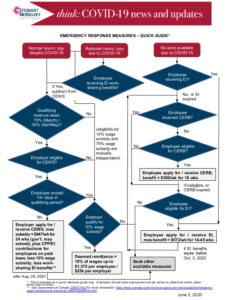Taking stock: Quick reference guide for government initiatives
*Flowchart below last updated June 2, 2020 (Originally published April 14, 2020)
With the passing of Bill C-14, the COVID-19 Emergency Response Act, No. 2 on April 11, 2020, the federal government has now laid a legislative foundation for various initiatives to assist employers and employees who are affected by COVID-19. The main measures include:
- The new Canada Emergency Response Benefit (“CERB”)
- The new Canada Emergency Wage Subsidy (“CEWS”), a 75% wage subsidy for eligible employers for the 12-week period beginning March 15, 2020
- The new 10% Temporary Wage Subsidy for employers
- Enhanced access to Employment Insurance (“EI”) benefits, including streamlining applications to the EI work-sharing program
Details on emergency response measures have shifted over the past few weeks, as they have evolved in response to our ever-changing situation. We expect this evolution will continue in many respects; notably, we are still awaiting regulations to further clarify some details related to CERB and CEWS.
However, given that the legislation now appears to be place, it seems an opportune moment for a fresh look at the current landscape of options. Recognizing it is a busy time, it is our pleasure to provide a dynamic summary of the mutual interactions between CERB, CEWS, EI and the 10% wage subsidy. We trust this will serve as a helpful reference point when seeking employment and tax advice to find the best options in the circumstances.
*Link to printable PDF version here.
This article is provided for general information only. If you have any questions about the above, please contact a member of our Labour and Employment group.
Click here to subscribe to Stewart McKelvey Thought Leadership articles and updates.
Archive
Peter McLellan, QC and Level Chan On November 29, 2017, the Nova Scotia Department of Finance and Treasury Board released new regulations with respect to asset transfers between pension plans that are effective November 28, 2017.…
Read MoreRick Dunlop and Kevin Landry The federal government has opened its 60-day consultation period with the release of its Proposed Approach to the Regulation of Cannabis. The paper outlines a potential regulatory framework which could…
Read MoreJosie Marks and Lara Greenough As 2017 comes to a close, please find below a summary of significant 2017 legislative amendments in each of the Atlantic Canadian provinces as well as federally, along with a…
Read MoreBrian Johnston, QC and Julia Parent In response to the report of the House of Commons committee on pay equity, the federal Liberal government announced its intention to bring in legislation to better ensure that…
Read MorePaul Smith and Dante Manna On November 14, 2017, Bill 22, also known as the proposed Pooled Registered Pension Plan Act (the “NB Act”), was introduced in the New Brunswick Legislature. If passed, New Brunswick…
Read MoreAndrew Burke and Kevin Landry The Toronto Stock Exchange (“TSX”) has made two recent changes to the TSX Company Manual that will impact disclosure: A. It introduced a requirement for many corporate listed issuers to…
Read MoreJennifer Taylor There is a role for social justice in statutory interpretation, according to the Nova Scotia Court of Appeal in the recent decision of Sparks v Nova Scotia (Assistance Appeal Board). This case is…
Read MoreKevin Landry and Jamie Watson New Brunswick’s proposed cannabis regulatory scheme has been introduced. An initial press release was followed by the introduction of amendments to the New Brunswick Liquor Control Act, and the Motor…
Read MorePeter McLellan, QC & Level Chan In September 2017, Nova Scotia’s Department of Finance and Treasury Board announced that stakeholder input is being sought regarding potential permanent changes to the funding framework for defined benefit…
Read MoreAndrew Burke & Divya Subramanian Securities markets around the world are grappling with new concerns: As fintechs make cryptocurrency offerings such as Initial Coin Offerings (ICOs), Initial Token Offerings (ITOs) or other digital token offerings,…
Read More
